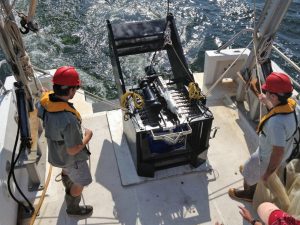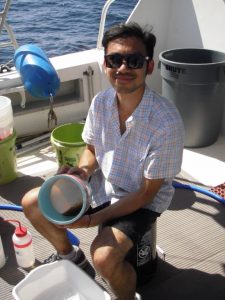Studies Highlight Complexities in Connecting Larval Fish Health to Deepwater Horizon
– MAY 9, 2017
Scientists examined Red Snapper and Spanish Mackerel larvae before, during, and after the Deepwater Horizon oil spill to determine if and how the spill may have affected them. The researchers observed that Red Snapper larvae were in poorer condition during and after the spill compared to pre-spill metrics, which may affect lifetime growth and fitness. However, this trend was also strongly related to peak freshwater discharge from Mobile Bay, though the mechanisms driving this relationship are unclear. Conversely, the condition of Spanish Mackerel larvae improved during the spill. Larval abundance or supply was not affected in either species. These results suggest species-specific responses to the oil spill as well as impacts from other environmental factors. The researchers published their findings in Environmental Research Letters: Condition of larval red snapper (Lutjanus campechanus) relative to environmental variability and the Deepwater Horizon oil spill and Marine Ecology Progress Series: Condition of larval Spanish mackerel Scomberomorus maculatus in relation to the Deepwater Horizon oil spill.
The Deepwater Horizon oil spill and subsequent chemical dispersant application overlapped with many fish species’ spawning periods, a vulnerable time for eggs and larvae. Relatively small changes in larval mortality rates from natural causes have the potential to cause order-of-magnitude changes in juvenile recruitment. Therefore, additional mortality related to the timing of the oil spill may have significant impacts on recruitment, affecting fisheries yields and management strategies.
Scientists compared Red Snapper and Spanish Mackerel larvae collected during long-term ichthyoplankton surveys of Deepwater Horizon-impacted sampling stations off the coast of Dauphin Island before (2007-2009), during (2010), and after (2011, 2013) the spill. The team assessed changes in larval body condition using weight-based indices and size-and-shape measurements. To assess potential effects from changing environmental and trophic conditions, the team examined background environmental conditions for Red Snapper larvae and whole-body stable carbon and nitrogen isotope measurements for Spanish Mackerel larvae.
Red Snapper larvae collected during and after the spill were skinnier and weighed less than pre-spill samples, but their body conditions appeared better at nearshore stations than offshore stations and improved as summer progressed across all years. Spanish Mackerel larvae collected during the spill were in generally better condition relative to pre- or post-spill larvae, as indicated by morphometric measurements and length-standardized dry weight. Stable isotope measurements did not suggest a change in Spanish Mackerel feeding patterns and were unclear in determining if Spanish Mackerel larvae assimilated oil carbon.
The researchers acknowledged that their study did not provide enough evidence to directly attribute the observed changes in larval body condition to the Deepwater Horizon spill and that the impacts could have resulted from other environmental factors. However, they noted that their findings do suggest that a combination of factors that coincided with the oil spill negatively impacted Red Snapper larvae compared to the more resilient Spanish Mackerel. Both papers highlight the importance of monitoring programs and need for long-term data collection.
Data used in these studies are publically available through the Gulf of Mexico Research Initiative Information and Data Cooperative (GRIIDC): Hernandez, et al., doi:10.7266/N7J964CB and Ransom, et al., doi:10.7266/N7J67DZM.
The study’s authors are F.J. Hernandez, Jr., J.E. Filbrun, J. Fang, and J.T. Ransom (Environmental Research Letters) and J.T. Ransom, J.E. Filbrun, and F.J. Hernandez (Marine Ecology Progress Series).
************
This research was made possible in part by a grant from the Gulf of Mexico Research Initiative (GoMRI) to the University of Southern Mississippi Division of Coastal Sciences for their project Resolving Deepwater Horizon Impacts on Highly Variable Ichthyoplankton and Zooplankton Dynamics in the Northern Gulf of Mexico.
The Gulf of Mexico Research Initiative (GoMRI) is a 10-year independent research program established to study the effect, and the potential associated impact, of hydrocarbon releases on the environment and public health, as well as to develop improved spill mitigation, oil detection, characterization and remediation technologies. An independent and academic 20-member Research Board makes the funding and research direction decisions to ensure the intellectual quality, effectiveness and academic independence of the GoMRI research. All research data, findings and publications will be made publicly available. The program was established through a $500 million financial commitment from BP. For more information, visit https://gulfresearchinitiative.org/.
© Copyright 2010-2017 Gulf of Mexico Research Initiative (GoMRI) – All Rights Reserved. Redistribution is encouraged with acknowledgement to the Gulf of Mexico Research Initiative (GoMRI). Please credit images and/or videos as done in each article. Questions? Contact web-content editor Nilde “Maggie” Dannreuther, Northern Gulf Institute, Mississippi State University (maggied@ngi.msstate.edu).







